Stronger institutions and better governance to carry out difficult reforms and ensure inclusive, green, and resilient growth are the order of the day.
Ambitious labor market reforms and investments in productivity enhancement and the green transition can boost the growth potential of Poland to four percent in the coming years, according to the new World Bank report, Living Up to Potential in the Wake of Adverse Shocks.
- War in Ukraine hastens EU push for more innovation
- How a small Hungarian town became PC giant Lenovo’s European hub
- Estonia tops Emerging Europe’s investment promotion survey; Prague takes business-friendly city title
After a recession due to the Covid-19 pandemic in 2020, the Polish economy rebounded swiftly and grew by 5.9 per cent in 2021.
However, the economy is projected to slow down in 2022-23 because of increased inflation, fuelled by energy and commodity price increases, uncertainty spurred by the war in Ukraine, and economic deceleration in its main trading partners in Western Europe.
“Two consecutive shocks, in quick succession, risk stalling the recovery in the EU countries, including in Poland,” says Gallina A. Vincelette, regional director for the European Union countries at the World Bank.
“The pandemic depleted national budgets and the war in Ukraine leaves governments facing an uphill battle to tackle rising inflation, low growth, and a cost-of-living crisis that is hitting the most vulnerable hard. But in the face of adversity lies opportunity. Stronger institutions and better governance to carry out difficult reforms and ensure inclusive, green, and resilient growth are the order of the day.”
According to the World Bank economists, Poland’s growth potential – a measure of the medium-term development capacity of the Polish economy – slowed from 3.7 per cent during 2002-07 to 3.3 per cent in 2010-19.
How a crisis can reverse years of gains
Going forward, successfully implemented reforms that offset the drag from a shrinking labour supply, improve the quality of human capital and aim for ambitious green and digital investment targets could help reverse this downward trend and boost Poland’s growth potential to four per cent during 2022-30.
“Scarred labour markets, tightening credit, disrupted supply chains, and slowing innovation have shown us how a crisis can reverse years of income gains,” adds Vincelette.
“But there is hope for correcting the course if countries invest prudently, prioritise life-long learning, and remove barriers to firm entry and trade while fostering more competition. Increased attention to the green and digital transition will also support potential growth.”
The World Bank’s report assesses multiple reform options to boost Poland’s growth potential. These include measures to counter the impact of ageing, boost inclusion, strengthen institutions and facilitate the green and digital transition.
Amongst others, the report highlights reform options that could help the country continue to increase its labor force participation rate. Although the increase in employment relative to 2019 is among the highest in the EU, the current retirement age of 65 years for men and 60 years for women is posing considerable challenges in the context of the demographic trends.
In addition, policies aimed at expanding access to digital connectivity could accelerate digital transformation and consequently support higher productivity of the Polish economy. At the moment Poland ranks among the bottom in the EU in the Digital Economy and Society Index with research and revelopment spending being among the lowest in the region.
Green agenda
Also, Poland is the second most greenhouse gas-intensive economy in the EU, and significant effort is needed to make progress on the green transition that would help the country reduce its emissions while also supporting energy security.
Climate change-related investments alone accounting for at least 37 per cent of the National Recovery and Resilience Plan are expected to cut emissions by a quarter relative to the pre-NextGenerationEU path. In addition to the options discussed in the report, the reforms included in the National Recovery and Resilience Plan provide a further upside to productivity and growth.
The report also suggests that similar reforms could boost growth in Romania, Bulgaria, and Croatia.
Romania could significantly outperform the previous decade, while Bulgaria and Croatia could see growth double from the current baseline scenario. These reforms could propel average potential growth during 2022-30 to 4.6 per cent in Bulgaria, 3.5 per cent in Croatia, and 5.2 per cent in Romania.
Undertaking ambitious reform agendas would set these EU member states on the path to stronger convergence with the EU average per capita income levels and offset adverse impacts from the pandemic and war.
Unlike many news and information platforms, Emerging Europe is free to read, and always will be. There is no paywall here. We are independent, not affiliated with nor representing any political party or business organisation. We want the very best for emerging Europe, nothing more, nothing less. Your support will help us continue to spread the word about this amazing region.
You can contribute here. Thank you.




Add Comment